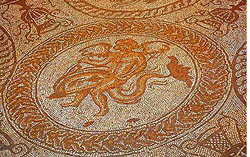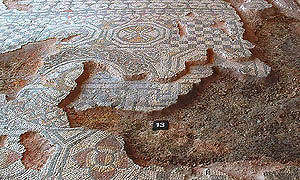Fishbourne Palace
by Kate Stout
 Luck is a funny thing. In 1960, excavations for a water main in Fishbourne, just west of Chichester, uncovered some Roman artifacts. What could have been a routine gathering of a few items for the local museum turned into a remarkable discovery, a massive Roman palace, with over 100 rooms from the first century AD. The Fishbourne Palace has twenty mosaic floors that are almost completely intact, located where their builders created them.
Luck is a funny thing. In 1960, excavations for a water main in Fishbourne, just west of Chichester, uncovered some Roman artifacts. What could have been a routine gathering of a few items for the local museum turned into a remarkable discovery, a massive Roman palace, with over 100 rooms from the first century AD. The Fishbourne Palace has twenty mosaic floors that are almost completely intact, located where their builders created them.
Fishbourne Palace is an overlooked treasure. Its size is impressive, while the lovely mosaics demonstrate the luxury of the Roman lifestyle. The mood at Fishbourne Palace is quiet and easy - this is not an overrun tourist site. The excavated site is enclosed, making it ideal for rainy day expeditions. On sunny days, the grounds and the restored Roman gardens are attractive and relaxing.
The big draw is the mosaics. The most famous mosaic at Fishbourne Palace is of Cupid riding a dolphin. It is delightful, showing a playful Cupid, trident in hand, on the back of a dolphin. They are encircled in a complex braided pattern. Other motifs in the mosaic are sea horses, scallop shells, and wine vases, no doubt a reference to one popular activity that took place in this lovely room.
 Some of the earliest mosaics, dating from 75 A.D., are in simple black and white geometric patterns. Craftsman brought to England from the Continent created these floors. The geometric patterns become increasingly complex in later floors. There are also colorful mosaics, with flowers, animals and pattern. In one spot, one mosaic floor is laid on top of another, proving that home improvement schemes are not new. Signs explain each mosaic's history.
Some of the earliest mosaics, dating from 75 A.D., are in simple black and white geometric patterns. Craftsman brought to England from the Continent created these floors. The geometric patterns become increasingly complex in later floors. There are also colorful mosaics, with flowers, animals and pattern. In one spot, one mosaic floor is laid on top of another, proving that home improvement schemes are not new. Signs explain each mosaic's history.
The palace, designed to demonstrate the power and grandeur of the Romans, is built on a massive scale. A quadrangle, with each side over 140 meters long (about 460 feet), encloses a Roman Garden, recreated based on the remains of the original gardens. By stepping into the garden, visitors get a sense of how large this Roman palace must have seemed to a villager in 75 A.D. One side of the palace is fully excavated. Touring the excavation, foundation stones outline the rooms. Parts of a bath and an under-floor heating system are also on display.
Fishbourne Palace has a small but excellent museum with items recovered from the site, and background information about the history of the site. Visiting the museum adds to an understanding of the mosaics. There are occasional tours throughout the day, and Fishbourne Palace sponsors a number of special activities related to Roman history and archeology.
While luck played its part in the discovery of Fishbourne Palace, don't wait until luck steers you to Fishbourne. It's just off the A27 in Fishbourne Village, West Sussex. To get there, take the A27 and about 1.5 miles west of Chicester, look for an exit marked for the attraction. Clear signs take you took the palace. An easy visit from Portsmouth, Chichester and Arundel, Fishbourne Palace is well worth a stop.
More Information:
We regret that we no longer have the resources to maintain up-to-date links and/or hours and pricing details for the various sites and attractions listed on this website. For more information about the location(s) listed above, please use your favorite search engine or visit Wikipedia.
Kate Stout writes about history and travel, with a particular interest in medieval and Tudor England. She also shares her enthusiam for stories from the past by writing history for children's magazines.
Article and photos © 2005 Kate Stout
|
